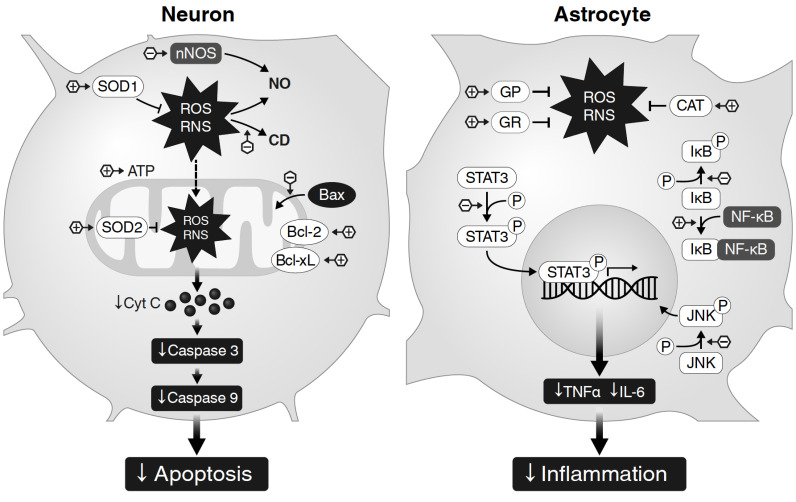Fig. (1).
Scheme of Tyr action mechanisms based on literature collected for this review. Despite a sufficient number of publications on the study of the antioxidant, anti-inflammatory, anti-apoptotic effects of Tyr, the studies performed on brain cells are sporadic and limited to studies conducted on cultures of neuronal cells [30, 48] and astrocytes [29, 105]. Therefore, the scheme reflecting the mechanisms of action of Tyr contains significant gaps that can be filled with the results of further studies. In neurons under conditions of oxidative stress, the action of Tyr is realized through up-regulation of anti-apoptotic proteins (Bcl-2 and Bcl-xl) и inhibition of apoptotic protein Bax translocation into mitochondria, which limits the release of cytochrome c and subsequent activation of the chain of caspase reactions, including a program of cell apoptosis. The downward trend in nNOS expression is manifested in a regular decrease in NO. Tyr significantly increases the expression of cytosolic SOD-1 and mitochondrial SOD-2, which reduces the severity of oxidative stress, and in an in vivo experiment on a global ischemia model can help reduce the content of lipid peroxidation products (conjugated dienes) in the brain tissue. In astrocytes under hypoxia/reoxygenation (as models of ischemia / recirculation) Tyr protects cultured astrocytes reduces ROS overproduction by increasing the activity of antioxidant enzymes (GR, GP, CAT), attenuates the released TNF-α and IL-6 from astrocyte via regulating of JNK. The reduction of cytokines from astrocyte might be due to its inhibition of astrocyte activation and regulation of the STAT3 signaling pathway since Tyr attenuates the expression level of GFAP and the phosphorylation of STAT3. At last, Tyr prevents the degradation of IκBα, which leads to the suppression of NF-κB function. + or - in the hexagon indicate the direction of Tyr action (activation or inhibition, respectively). (A higher resolution / colour version of this figure is available in the electronic copy of the article).

